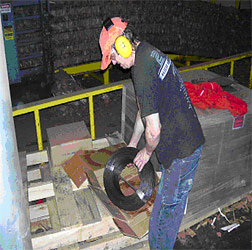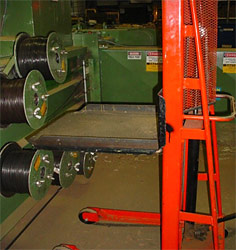Transport and installation of bailing wire coil on baler
Company: AF&PA member company
Industry: Box Plant - NAICS Code 322211
Task: Transport and installation of bailing wire coil on baler
Employees: 118 (number at the site)
Success Brief:
We were able to substantially eliminate the significant manual material handling activities associated with the transport and installation of coils of baling wire on a baler through the use of a hand truck with a height adjustable lift table (toe plate).
The Problem:
A boxed coil of baling wire weighs 100 pounds. The boxes of wire coils come in from the supplier on pallets. Each coil must be removed from its box and placed on one of the spindles on the baler designed to support the wire coil as wire is drawn from the coil and fed into the baler. The spindles are located 2 to 4 feet above floor level. Limited physical access to the baler side frame prohibits use of a forklift to handle the wire coils. In the past, an employee would remove a spool of wire from the box (usually at whatever height the box happened to be on the pallet), lift the spool, and manually carry it to the baler. At the baler, the employee would support the spool while positioning and installing it on the horizontal spindle, either alone or with the assistance of another employee. To reduce the amount of deep bending and lifting from low heights, the pallet of boxed coils was raised by stacking it on top of an empty pallet. An ergonomics assessment suggested that the task posed a potential risk of associated musculoskeletal disorders in the back and/or the upper extremities.
The Solution:
A hand truck with a height adjustable lift table was purchased to transport position and install the wire coils on the baler. The following procedure for transport and installation of the wire coils was developed and communicated to affected employees when the equipment was provided:
- The box containing the wire coil is moved from a pallet onto the lift table (positioned at the same height as the pallet) without removing the wire coil from the box. A sliding or rolling motion is used to move the box, eliminating lifting.
- The box is then transported to the baler using the hand truck.
- The box is cut open and peeled away from the wire coil.
- The end plate of the spindle is unbolted and removed.
- The lift is positioned next to the shaft of the horizontal spindle on the baler that will hold the wire coil.
- The wire coil is turned upright (This is the ONLY significant manual effort needed to perform this task, and it involves less than 50 pounds of force.) so that the opening in the center of the wire coil is lined up with the horizontal shaft of the spindle on the baler and the wire coil is pushed (so that it slides) onto the spindle.
- During this installation process, the wire coil is NEVER lifted off the ground or onto the baler by human force.
- The end plate of the spindle is bolted back into place, then the tape is removed and the wire is threaded into the baling mechanism.

BEFORE PICTURE

AFTER PICTURE
The Impact:
The use of a hand truck with an adjustable lift table to transport and install coils of baling wire has significantly reduced the force and awkward postures required to move and install the wire coils, resulting in a significant reduction in the risk of associated musculoskeletal disorders. Additional measures that might be considered would include placing the pallet on a mechanical device that would allow it to be raised and lowered (e.g., pallet jack, scissors lift).
Source:
- AF&PA; PPSA (August 2007).

